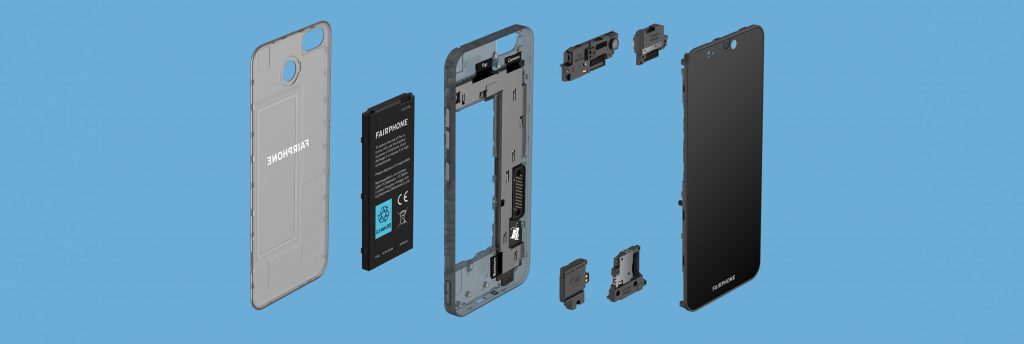
How sustainable is the Fairphone 3?
At Fairphone, our dedication to change means a dedication to measurement. We’ve just completed the life cycle assessment on the Fairphone 3, and we’re humble-proud to present our results.
As with the Fairphone 2, we turned to the independent experts at the Fraunhofer Institute IZM to examine the phone’s lifelong environmental impact – from the mine to the factory to the store to your pocket to the product’s end of life and the recycling of its materials and parts. It’s a measure of the relative evils involved in modern electronics, from how much the Fairphone contributes to our planet’s CO2 burden to the human and environmental impact of its materials to the toll it takes on the reserves of scarce natural resources.
The results validate three key elements of the Fairphone strategy: the value of longevity and modularity in reducing a phone’s lifelong environmental cost, and the positive impact of using reused and recycled materials.
Modularity matters: the biggest impact is the phone’s core
When Fraunhofer Institute looked at the relative contribution of the phone’s parts to its CO2 emissions, they found at least 70% of the carbon footprint is in the core — the central module that contains the system-on-a-chip (think of it as the brains). That’s the part of the phone that you’re least likely to change and the one we want to make last the longest. By ensuring that you can easily swap out less carbon-intensive modules like the battery, the camera, and the display, which each account for only 5-7% of the footprint, we can keep your core module going longer.
What’s more, we’ve achieved big improvements in the carbon cost of module production. In the Fairphone 2, the modular parts contributed to 12% of the CO2 emissions in production, while in the Fairphone 3, they represent only 2.3% of the emissions in production. We’re designing for repairability at an even smaller carbon overhead.
On top of those savings, every time we refurbish a module, we further save lifetime CO2. When you extend the life of your phone by swapping a part, and we refurbish and reuse that module as a repair part, we’re extending the life of another one of those precious core units, and we can save up to 95% emissions in some modules.
Longevity is key: the longer your phone lives, the more the planet prospers
The life cycle assessment of the Fairphone 3 confirms something we’ve known since Fairphone’s inception: the longer a device is used, the smaller its environmental footprint. But barriers to smartphone longevity remain an issue. A key component of longevity is connected to the continued software and security support of phones. When the operating system and software that run on older core units stop being supported, the drop-off in usability and security is steep. This is why we, shoulder to shoulder with the Fairphone community, have been working so hard to continue providing software support.
The Fraunhofer Institute’s report reveals that the use of a smartphone for five to seven years can reduce CO2 emissions per year by a whopping 28-40%. Despite our steady march to longer product use, there is still some way to go before seven years of use is a reality. With Fairphone 2 and the software upgrade, empowered by community projects, to android 9, we will very almost certainly hit or exceed the mark of 6 years support. We hope to see Fairphone 3 make it even further, but a little help from our friends in the software industry could make that a less resource-intensive task.
Train transport: it’s how we roll now
Transport is another big contributor to CO2 emissions. Most phones in Europe arrive by air freight. That turned out to be a major contributor to the overall footprint of the phone, and in the case of smaller modules, actually exceeded the carbon cost of their production. We’re proving that’s unnecessary.
Your Fairphone 3 journeys from China to our distribution center in the Netherlands by train freight now, which lowered emissions by 87%. Both ocean transport and rail transport are lower carbon options that the entire industry could adopt. Phones don’t need to fly.
Recycling rocks: virgin plastic is screwing the planet
When it comes to components like the case, bumpers, and even that little screwdriver that comes with your phone, an important contributor to our lowered footprint is maximizing the use of recycled materials. The life cycle assessment reports that depending on the type of plastic, recycled sources generate 5 to 10 times less CO2 emissions than their virgin counterparts.
Bottom Line: hold on to that phone for dear life
We’d love to be able to show you how Fairphone stacks up to other phones, but few in the industry conduct even the most cursory analysis on their phones, and nobody transparently reports the calculations or assumptions behind their data. And no matter how proud we may be of our efforts, and the improvement in those efforts, we need the rest of the industry to follow in our footsteps and help people use their phones for a longer time. At the end of the day, the phone you have in your pocket, whether it’s a Fairphone or not, is going to follow a simple law of nature: the longer you use it, the more lightly it will have stepped upon the Earth.
Share this post
The post you are currently reading is an AMP HTML document; an optimized version for mobile usage to increase loading speed and decrease data usage. To see our full website you can visit our own mobile version of this post.